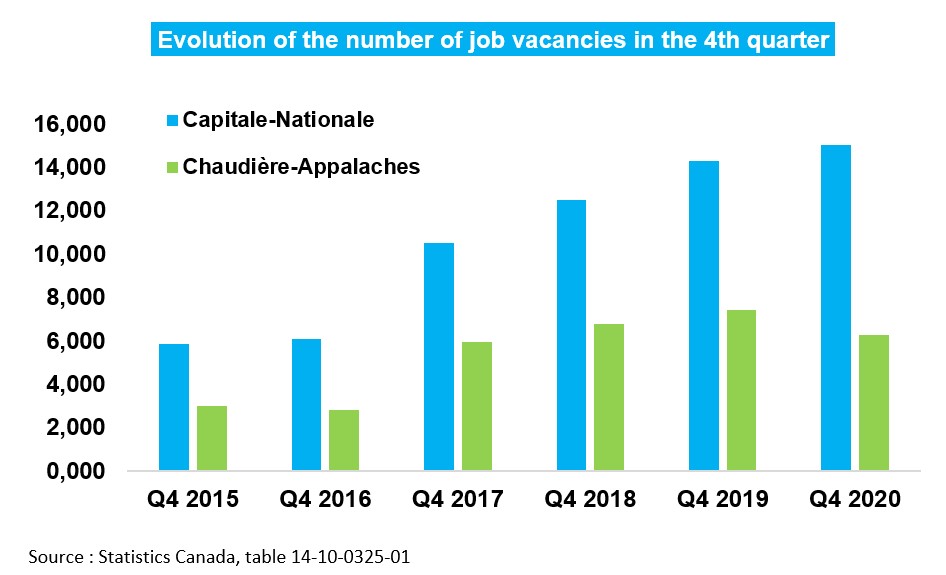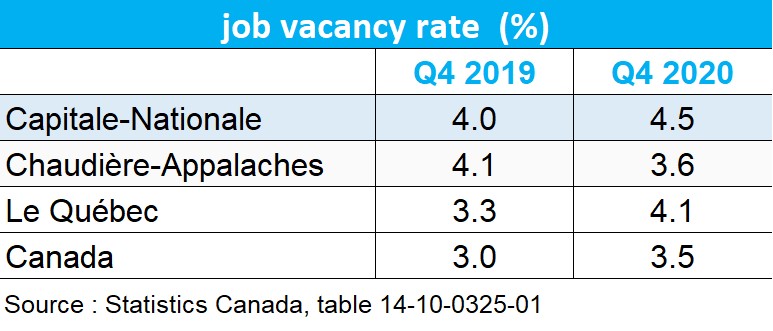Highlights
- In the fourth quarter of 2020, Statistics Canada estimated that there were 15,010 vacant positions in the Capitale-Nationale administrative region and 6,265 in the Chaudière-Appalaches region.
- Compared to the fourth quarter of 2019, this is a 5% increase in the number of vacancies in the Capitale-Nationale and a 15% decrease in Chaudière-Appalaches.
- The proportion of vacancies for each region followed opposite curves in the fourth quarter of 2020, as the job vacancy rate increased to 4.5% in the Capitale-Nationale and dropped to 3.6% in Chaudière-Appalaches.
- Workers in the occupational categories “sales and service”, “health” and “trades, transport and equipment operators” were some of the highest in-demand.
- On average, the hourly wage offered for vacant positions was $21.75 in the Capitale-Nationale and $19.80 in Chaudière-Appalaches. The wages offered in the province of Quebec and Canada were $21.50 and $22.50, respectively.
Charts


Commentary
Statistics Canada’s Job Vacancy and Wage Survey (JVWS) estimations for the fourth quarter of 2020 reflect the labour market situation after nine months of the pandemic, as employment was reaching similar levels to those observed in the last quarter of 2019.
The number of vacancies in the Capitale-Nationale and Chaudière-Appalaches regions reached 15,010 and 6,265 in the fourth quarter of 2020, a record high in the Capitale-Nationale for that period of the year, and a decrease in Chaudière-Appalaches. Compared to the same period last year, this is a 5% increase in the Capitale-Nationale and a 15% drop in Chaudière-Appalaches.
The job vacancy rates reached 4.5% in the Capitale-Nationale and 3.6% in Chaudières-Appalaches in the fourth quarter of 2020. This is a peak for that period of the year in the Capitale-Nationale, while it is the third-highest rate registered in Chaudière-Appalaches. Although the job vacancy rate remains higher in the Capitale-Nationale than in the province of Quebec (4.1%) and Canada (3.5%), it has dropped below the provincial rate in the Chaudière-Appalaches region.
On average, the hourly wage offered for vacant positions was $21.75 in the Capitale-Nationale and $19.80 in Chaudière-Appalaches in the fourth quarter of 2020. Compared to the same period in 2019, these wages grew by 9.6% and 4.5%, respectively. This increase was higher than in the province of Quebec (+4.1%) and Canada (+3.4%), with hourly wages established at $21.50 and $22.50.
Workers in the occupational categories “sales and service”, “health”, and “trades, transport and equipment operators” were some of the highest in-demand.
Capitale-Nationale (15,010 positions)
- Assisting occupations in support of health services (1,285)
- Computer and information systems professionals (690)
- Other sales support and related occupations (520)
- Paraprofessional occupations in legal and social (490)
Chaudière-Appalaches (6,265 positions)
- Food counter attendants and kitchen helpers (435)
- Labourers in processing, manufacturing, etc. (340)
- Other sales support and related occupations (240)
- Motor vehicle and transit drivers (230)
The JVWS estimations allow us to draw a portrait of the year 2020, marked by a pandemic with unprecedented effects on the labour market. The strong decrease in employment last spring was followed by a quick rebound in most sectors, thus bringing the Capitale-Nationale and Chaudière-Appalaches regions back to the same labour scarcity challenges as before. The gradual reopening of all sectors will assuredly contribute to tightening the region’s labour market.
Note to readers
- The job vacancy rate is the number of job vacancies expressed as a percentage of labour demand, i.e. all occupied and vacant jobs.
- JVWS data is not seasonally adjusted. Therefore, quarter-to-quarter comparisons should be interpreted with caution as they may reflect seasonal movements.
- The target population of the survey includes all business locations in Canada, excluding those involved primarily in religious organizations and private households. Federal, provincial and territorial administrations are also excluded from the survey.
- To learn more about the minor groups in the National Occupational Classification [NOC] presented above, please visit the Government of Canada’s website.
- Note that data by trade is provided for information purposes only and must be considered with caution due to the sample size.
Franck Ndefo
Economist
Québec International




